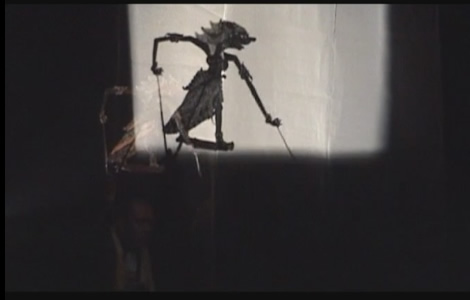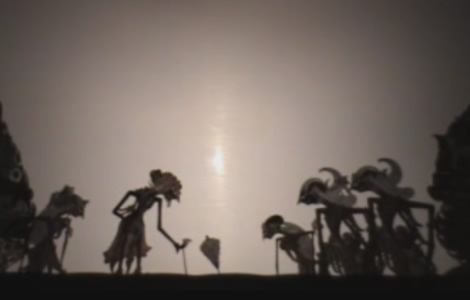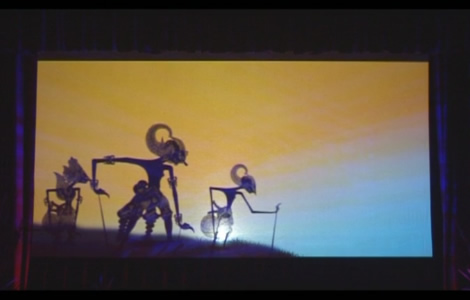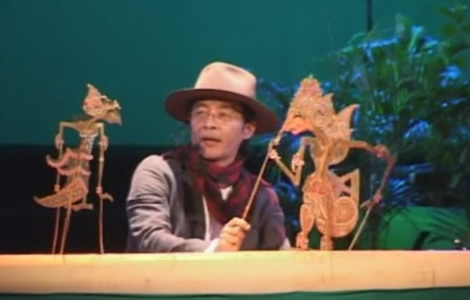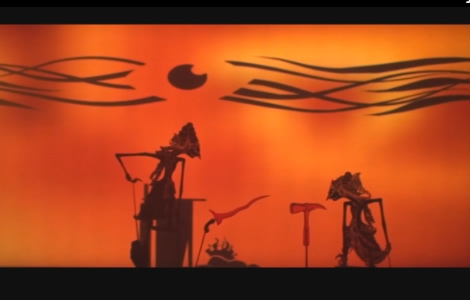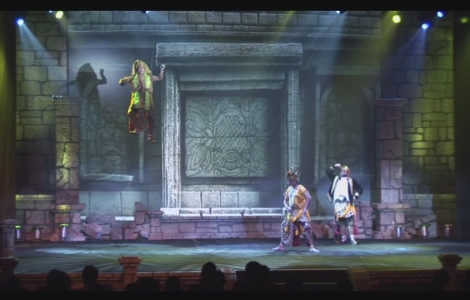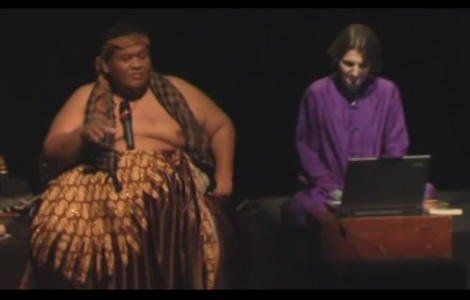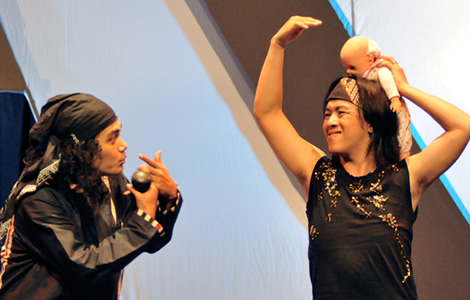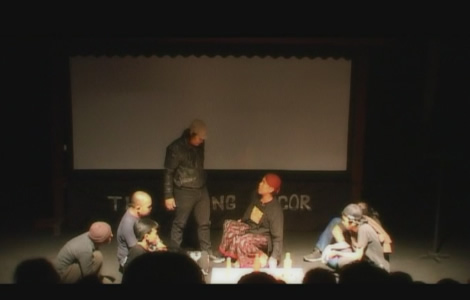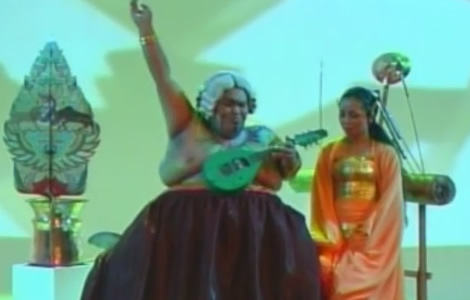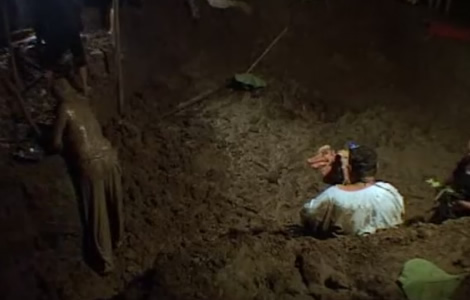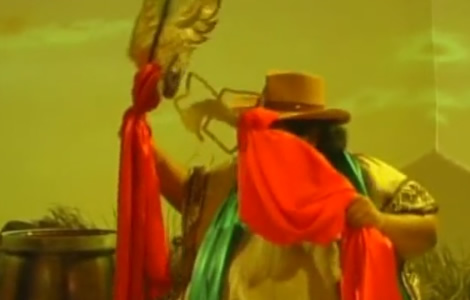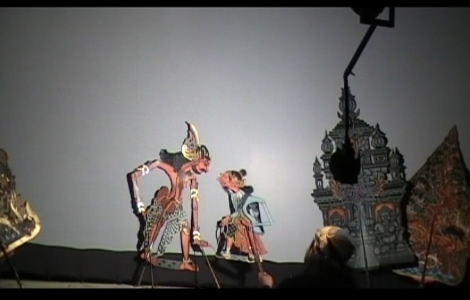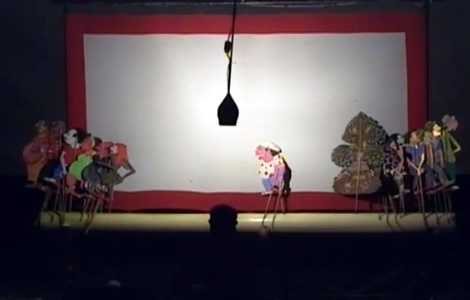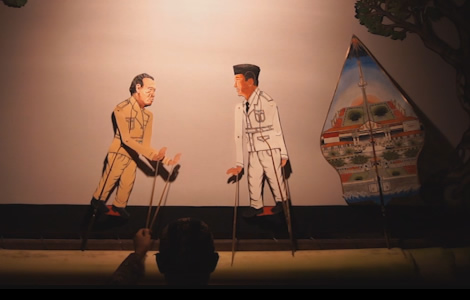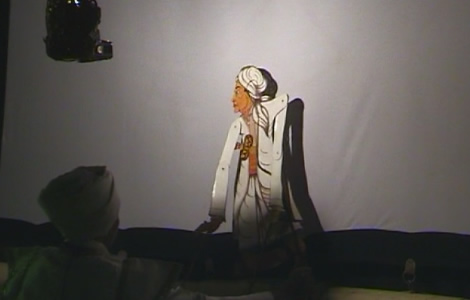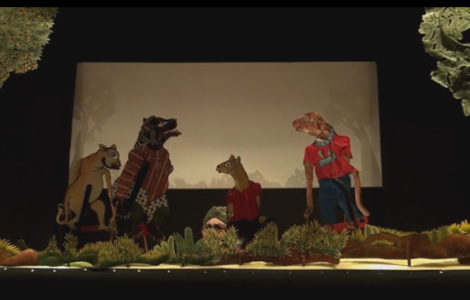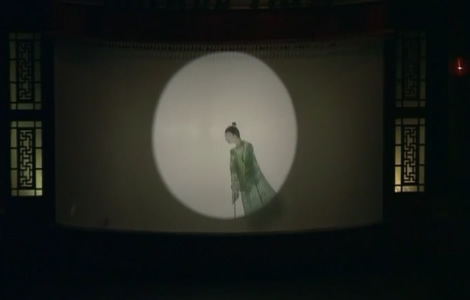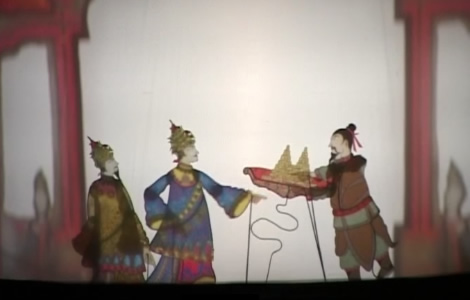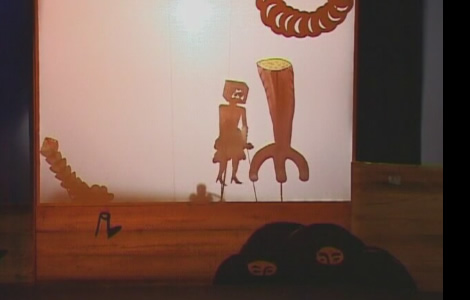0
In this section I consider two interrelated practices: the making of the puppets and their usage in performance. I learned the basics of puppet making from Pak Bandi, an irascible and warm man who lives in the village of Gendeng, south of Yogyakarta. For several weeks, I would drive an hour from the North of Yogyakarta, avoiding the city by taking the Ring Road, and arrive at his studio in the morning. He worked at a large table installed in a porch just outside his house. Inside the house he had several paintings and glass engravings. Across from the porch, on the other side of a terrace there was a small bamboo-walled room where his sister's family produced tempe. He would sometimes not even look up as I sat down at the large table across from him. His bold head and tiny glasses gave him an air of passionate imperturbability, that reminded me simultaneously of a watchmaker and a monk. But as we worked through the morning, he would begin talking longingly about the old days and the corruption of the current times.
He would reminisce sadly about the times when 70 percent of the village he inhabits was dedicated to the noble art of wayang puppet making, a proportion that has decreased to less than 5 percent in present times. Today, most of the children in the village are studying English rather than Javanese and dream of leaving for the city, much to the disdain of Pak Bandi. Pak Bandi is a man of high standards and inflexible daily rituals. At 12 pm, he would stop his work and drive across the village to a specific place where they make gado-gado. There are many more such places nearby, but he would only go to this one place. Sometimes he would insist on bringing the food himself and sometimes I would go there with him. During lunch he sometimes asked me questions about my own home.
"Do you speak a local language or only English?", he asked. "I speak Spanish," I added to his confusion. "Why Spanish, is there no local language?" I summed up the colonial past of my country in two sentences. "So you don't speak any local dialect?" he insisted. I disappointed him with my negative answer. "Wah! I am sure your grandfather must be angry at you." I told him my grandfather also didn't speak any local languages and his disappointment only grew. He was probably imagining a land plagued by the cultural amnesia he sees in his grandson. In any case, he never asked about my country again.
I spent several weeks chirping off bits of leather and adding colors to the puppets. I did not become by any means a proficient carver, but this short experience brought certain qualities of the puppets to my attention. At every step of the process, they are made for the performance. The upper half of the puppet is made thinner so that it is easier to hold. The hinges and handles are carefully placed to guarantee optimal flexibility and comfort. I would later spend many years trying to learn how to bring them alive.
I first started to learn how to control the puppets from Pak Parjaya, but his pedagogical principles were too mysterious for me. In a normal session, he would take two random puppets and show me their respective motions. When I asked him to repeat them for me, he would do something completely different, often with different puppets. Through the six months of this first learning experience I was able to familiarize myself with a wide array of patterns of motion, but it was impossible for me to commit any of them to muscular memory. The teaching approach itself did not allow for nuanced, precise reproduction of the movements.
When I returned to Indonesia in 2012 for my official, year-long fieldwork, I enrolled at Habirandha, the pedalangan school of the Yogyakarta Kraton, where I encountered a more formalized teaching environment. In stark contrast with the stochastic pedagogy of Pak Parjaya, here we worked on just one 20-minute scene for an entire year. The scene was repeated each week in the different classes, so we could pay attention to the handling technique (sabetan), the music and the narration. All the puppet movements had been carefully dissected for didactic purposes. A set of puppet positions, from 1 to 10, were abstracted into diagrams that decorated the practice room. Most of the students came from non-dalang families and for once, everyone else was as bad as me. But this system, which was considered ridiculous by my dalang friends and which could easily be made into a Pedalangan for Dummies book, was wonderful to me. It allowed me to learn how to move the puppets and it provided me with ample opportunity to satisfy my researcher's curiosity. Unfortunately, due to the constant need to travel and attend other performances, I was unable to continue the course. But I kept taking private lessons from one of my teachers, Sri Mulyono.
I also have some experiences making, or participating in the creation, of non-conventional puppets. For my first wayang performance in 2008, I drew some characters based on Mexica (Aztec) characters and gave them to Ki Toro, who is both a dalang and a puppet maker and asked him to have them carved out.
They were supposed to be used in a performance that mixed projections and puppets and they were colorless. However, I asked Toro to maintain the kinetic conventions required for the efficient and comfortable manipulation of the puppets. Not all kontemporer puppets adhere to this philosophy. Sometimes the new creations are meant to be visually appealing and they create challenges to the puppeteer. Catur Kuncoro told me once that the puppets created by Eko Nugroho required him to learn (or rather, invent) a new way of handling them. Eko's puppets have sharp edges and hinges located in the midst of thick limbs. This make conventional handling techniques useless. The puppets are also bigger and heavier than conventional ones and Catur cannot hold two of them at the same time, adding to the challenges the dalang needs to overcome.
Innovations in puppet design can require new handling techniques. But the new handling technique itself can constitute the innovation. This is required, for example, when working with projectors. In my first and only kontemporer project called The Secret Life of the Volcanoes, I combined puppets and projections. The projection changes the idea of the screen. A white screen is an empty space, with more semiotic flexibility than a projected image. The movement and dialogue of the puppets can trigger changes in the perception of the space, as it is imagined by the spectators. By contrast, a fixed image limits the imaginative possibilities and requires a more realistic progression between one space and the next.
The puppets can be understood in terms of both symbolism and embodied interaction. The conventional usage of puppets upholds the poetics of both aspects. Wayang puppets have disproportionately long hands. According to my teacher, Pak Parjaya, this represents human insatiability. But this is not their only symbolic function. On a pictorial level, they represent specific character traits. As Jan Mrázek describes, they are a combination of frontal and profile depictions of the characters. The colors, morphology and angle of the head are all indicative of inner qualities of the particular character represented. Some characters might be represented by different wanda (literally "face", a version of a puppet in a specific state), depending on the particular moment of the story when the puppet appears.
Several performances that may be classified as kontemporer still use the puppets in such a way: Lara Tanpa Liru, Sugriwa Dan Subali, Kalimataya, Kasmaran Tak Bertanda and Wayang Mitologi. However, these performances differ greatly from one another.
In Figure 2.1, we see one of the actors holding the puppet of Arimbi behind the screen. On the screen a clearly delineated shadow of the puppet and control rods is discernible. This image provides a good representation of what happens throughout the performance: all puppets are fully traditional, like the one appreciated here, but their positioning in the space is not.
FIGURE 2.1. Arimbi in Lara Tanpa Liru.
This is not very different from that which we can appreciate in Kasmaran Tak Bertanda (Figure 2.2). In this performance, the dalang and the puppet can be clearly seen denoting an unconventional spatial arrangement. In both cases, shadows are projected onto screens at certain moments in the performances.
FIGURE 2.2. From left to right: Dewi Indradi, Resi Gotama, the Cupu Manik Astagina, Anjani, Guwarsa and Guwarsi in Sugriwa dan Subali.
A very different image is presented in Sugriwa dan Subali (Figure 2.3) where all aspects denote a traditional approach: the puppet construction, usage and spatial arrangement. Even the story, though not its duration, is traditional.
FIGURE 2.3. Kresna, Bima and Arjuna in Kalimataya.
A third set of performances that use conventional puppets do so in combination with digital images. In Figure 2.3, we see Kresna, Bima and Arjuna, represented by conventional puppets against a digital backdrop, in Kalimataya.
FIGURE 2.4. Sujiwo Tejo manipulates Satiawati (left) and Prabu Santanu (right) in Kasmaran Tak Bertanda.
Likewise, in Wayang Mitologi there is a combination of digital images and shadows of traditional puppets (Figure 2.5). However Wayang Mitologi constitutes an important exception among performances that use conventional puppets. In this performance, conventional puppets are used to represent characters outside of the purwa story cycles.
FIGURE 2.5. From left to right: Empu Rama and Empu Permadi in Wayang Mitologi.
What does this variety tell us about the usage of conventional puppets? We have seen performances where the spatial arrangements and the characters depicted are traditional (Sugriwa dan Subali), performances where spatial arrangements are not traditional but the characters depicted are (Kasmaran Tak Bertanda, Lara Tanpa Liru, Kalimataya) and performances where both the spatial arrangements and characters depicted are not traditional (Wayang Mitologi). Looking at the puppet variable in isolation proves that using conventional puppets can suit many different artistic agendas, since the performances are thematically and aesthetically very different from one another. Some of them are very conservative in terms of their themes (such as Sugriwa dan Subali) whereas others include scenes of political parody (such as Wayang Mitologi) or are critical of conventional ethical values (such as Kalimataya). Even the visual atmosphere in which traditional puppets are inserted can be wide ranging: it can be fully traditional, it can be a traditional screen combined with lights, or an altogether different setting.
But do these performances still have something in common? Yes, since in all cases the conventions for pictorial depiction and the materials used were kept intact, maintaining the visual legacy of the puppets within kontemporer performance contexts. This was a relatively unusual choice by the dalang in the selection considered in this dissertation. Only five performances use conventional puppets, whereas 12 use combinations and 7 use non-conventional ones. One reason for this is the influence of Sukasman in the development of wayang kontemporer. Being a visual artist and puppet maker, for him innovation in wayang was intrinsically tied to new ways of making and depicting puppets. However, the five performances described above demonstrate that it is possible to use time-honored puppet conventions within a multiplicity of artistic projects that are still works of contemporary wayang.
These performances maintain the ways characters are pictorially imagined, pledging silent advocacy for the traditional etiquette of embodied interactions between body and skin, controller and controlled, even in the most contemporary wayang shows.
There are many ways in which traditional and non-traditional ways of portraying characters can be combined in kontemporer performances. The combinations can also include new protocols for the interaction of puppets and people. In all cases, these new versions open up intermediate spaces for negotiations among flesh, skin and other media, which include: combinations of puppets and actors, different roles for the dalang (which can include more than one dalang per show), the intermingling of traditional and non-traditional puppets, or the combination of different traditional puppets not commonly used together (kulit and golek). They also allow for the emergence of new visual constellations of the wayang puppet morphology and its corresponding symbolism.
In some cases, there is a combination of puppets and actors, as in Jabang Tetuka and Wayang Hip Hop. In Jabang Tetuka the same characters are represented in different media. Arjuna is sometimes a puppet, sometimes a live actor and sometimes an actor recorded on video (Figure 2.6 and Figure 2.7). The same is true for most characters, although some appear only in puppet form.
FIGURE 2.6. An actor representing Batara Guru is suspended by cables in Jabang Tetuka.
FIGURE 2.7. The shadow of a conventional puppet representing Batara Guru as he speaks with the mortals, in Jabang Tetuka.
However, in Wayang Hip Hop, each character has a stable representation. The punokawan are always represented by traditional puppets, while Arimbi, Gatotkaca, Bilung and Bima are always represented by the same live actors (Figure 2.8).
FIGURE 2.8. From right to left: Bilung (as actor), the dalang and puppets representing Gareng and Petruk, in Wayang Hip Hop.
In some performances, the dalang doubles up as actor. In Cebolang Minggat, Slamet Gundono acts out some of the characters, as he and Elizabeth read out certain narrative fragments (Figure 2.9).
FIGURE 2.9. Slamet Gundono portrays Nur Witri and Elizabeth Inandiak portrays Cebolang in Cebolang Minggat.
In Jendral Karna, Slamet represents both Arjuna and Karna in the final duel where the latter dies. This was accomplished by a juxtaposition of video recordings of the dalang (Figure 2.10).
FIGURE 2.10. Slamet Gundono portrays both Karna(right) and Arjuna (left), in Jendral Karna. A conventional kayon puppet is seen in the background.
Besides portraying characters, sometimes the dalang represents himself, as a dalang, on stage. In some cases, he can use this to interact with actors. In Sanditama Lagu Laga the dalang acts as the director, coaching a group of kids who are putting on a show about certain wayang characters (Figure 2.11).
FIGURE 2.11. The dalang Nanang Hape coaches a young man to portray a character in Sanditama Lagu Laga.
A similar device is used in Perseteruan Getah Bening, where the dalang sells magical potions before the performance begins (Figure 2.12).
FIGURE 2.12. The dalang Catur 'Benyek' Kuncoro (with the red hat) sells magical potions in the first part of the show.
Another example is Pertaruhan Drupadi (Figure 2.13), where Slamet talks to Drupadi, portrayed by an actress, advising her to find her own answers on how to lead her life (for a fuller description of this dialogue see Women).
FIGURE 2.13. Slamet Gundono and an actress representing Drupadi in Pertaruhan Drupadi.
Other performances combine traditional and non traditional puppets. In Wayang Tanah, most puppets are lumps of soil or other natural elements such as leaves (Figure 2.14). But Togog is a conventional leather puppet (Figure 2.15).
FIGURE 2.14. Slamet Gundono moves a puppet made of a leaf that represents the kayon.
FIGURE 2.15. The dalang holds a traditional puppet representing Togog.
In Jendral Karna and Pertaruhan Drupadi some puppets are represented by leather puppets, others by cooking utensils and others by suket (grass) puppets (Figure 2.16 and Figure 2.17).
FIGURE 2.16. Slamet Gundono holds a conventional leather kayon in his right hand a suket puppet representing Bima in his left hand.
FIGURE 2.17. Slamet Gundono uses spoons and other cooking utensils to portray characters.
Other performances where the puppets can be considered intermedial are those which use new versions of traditional puppets, also made of leather but which constitute variations on the traditional iconography. The most telling example is Enthus Susmono's Dewa Ruci (Figure 2.18). Here, the dalang uses a puppet of Bima that looks more human like (and a little like Enthus himself!) and a kayon that is more realistic in its depiction of trees.
FIGURE 2.18. New puppets created by Enthus Susmono: Bima, Durna and a new kayon.
Another example is Wayang Ukur. As mentioned in Aesthetics, Sukasman created new puppets based on existing wayang conventions. This can be appreciated in the puppets used in Sungsang Bawono Balik, which consist of slightly modified shapes of conventional puppets (Figure 2.19).
FIGURE 2.19. New versions of Canggik and Limbuk created by Sukasman in Sungsang Bawono Balik.
Lastly, Sumpah Pralaya must be considered intermedial as it combines wayang golek puppets, projections and wayang kulit puppets (Figure 2.20). Sometimes these combinations have narrative functions. For example, in the opening scene, a golek puppet representing Abimanyu thinks about his past. The episode he remembers is presented in the background, through the shadows of kulit puppets combined with digital images (Figure 2.21).
FIGURE 2.20. Two wayang golek puppets interact in front of a row of several leather kayon.
FIGURE 2.21. An image from Sumpah Pralaya. In the background, there are digital images and shadows created by wayang kulit puppets. In the foreground, there is a wayang golek puppet and a leather kayon.
Most of the performances considered in this dissertation can be classified as mixed in their usage of puppets. The previous overview lists eleven performances that play with embodiment, interaction and iconography. This playfulness leads to a great variety of intermedial possibilities in the combination of wayang puppets and other media, as well as modified versions of conventional puppets. Some of these performances re-imagine embodied cultural memory by offering unusual interactions between puppets and people. These can be combinations of puppets and actors, the combination of traditional and non-traditional puppets, the combination of different traditional puppets not commonly used together, or they can include different roles for the dalang. Other performances considered in this category selectively modify the iconography of the puppets to portray characters through unprecedented visual configurations, while still drawing from the tradition.
However, all of these performances took place within either mixed or non-conventional spatial configurations. Some dalang used traditional wayang in new spaces, and (as we will see) some used non-conventional puppets in traditional spatial settings. But mixed puppets were never used in traditional spaces. Why? One can easily imagine that at some point one dalang will do this (or perhaps this has already been done but I am unaware of it). However, the lack of such a combination in this sample is worth commenting on. I don't suggest there is an intrinsic, unavoidable rule preventing such combinations. But there seems to be a limit to the places where liminal wayang beings were welcome, and these cyborg creations were only invited to inhabit spaces that were either wholly non-conventional or, at least, also hybrids.
Another striking characteristic is that most of these performances assumed non-conventional views on ethical themes. The only exception here is Sumpah Pralaya, which adheres to quite traditional notions of behavior. But it is tempting to suggest that a change in the material of the puppet corresponds to a change in the material of the story. Perhaps this is more than just a coincidence. In Indonesian, the word bahan can be used to describe the material of which the puppet is made but it can also describe the "material of the story" or bahan cerita.
My main criteria for classifying performances in this category are that both the characters portrayed and the way the puppets are made must depart significantly from the tradition. However, it is possible to distinguish between two ways in which this is done: some dalang loosely follow conventional guidelines for non-conventional puppets made from leather while others use non-conventional materials for the creation of the puppets as well. The nuanced distinction between the materials is important since the leather (kulit) is part of the ontology and even the name of conventional wayang kulit. Later in this section, I will analyze a performance that explores this material substitution thematically (Wayang Onthel).
Some performances use leather puppets that depart from conventional construction guidelines and that represent non-traditional characters. This is the different to the puppets described as intermedial, which are new versions of conventional characters. The performances in this subcategory are Wayang Kampung Sebelah (Figure 2.22), Wayang Republik (Figure 2.23), Raden Saleh (Figure 2.24) and Wayang Kancil (Figure 2.25).
FIGURE 2.22. The presenter in Wayang Kampung Sebelah.
FIGURE 2.23. From left to right: Hamengkubuwana IX, Sukarno, and a kayon representing the city of Yogyakarta. In the kayon, from top to bottom: the Merapi Volcano, the Tugu Malioboro Monument, the kraton, the Pelangkung Gading and the South Sea.
FIGURE 2.24. Raden Saleh in the eponymous performance by Ledjar Subroto and Ananto Wicaksono.
FIGURE 2.25. Puppets representing trees, plants and different animals in Wayang Kancil.
There is another performance where the puppets could be said to work in a similar way: Wayang Kancil, a performance where new creations, also made by Ledjar Soebroto, represent the characters from the Serat Kancil (see Environment). The puppets are made of leather but they represent characters that are outside of the purwa story cycle.
Some performance use puppets made from other materials, such as plastic. This is the case for Sie Jin Kwie (Figure 2.26) and Sie Jin Kwie Kena Fitnah (Figure 2.27), as well as for the Wayang Bocor performances: Bungkusan Hati Di Dalam Kulkas (Figure 2.28) and Peresteruan Getah Bening. In both cases the creators are visual artists who use the transparency of the plastic in order to generate colored shadows. The Sie Jin Kwie characters are inspired by the iconography of Chinese stories and the Bocor characters are creations of Eko Nugroho's imagination which he also uses for T-shirts, installations and videos (Figure 2.29).
FIGURE 2.26. A puppet representing the young Sie Jin Kwie in the eponymous performance by Teater Koma.
FIGURE 2.27. From left to right: a royal adviser, king Lisibin, and Sie Jin Kwie receiving golden coins as a present.
FIGURE 2.28. A puppet representing Cah Ayu in Bungkusan Hati Di Dalam Kulkas.
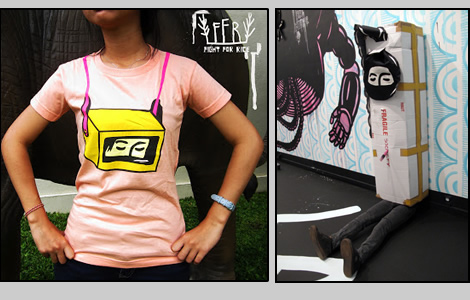
FIGURE 2.29. A woman wearing a T-shirt (left) and an installation by Eko Nugroho at the Musée de la Cité in Paris (right). Both are representations of the same type of characters depicted in Bungkusan Hati di Dalam Kulkas.
There is one performance that makes an explicit link between its material of choice and its theme: Wayang Onthel (Figure 2.30), where puppets are made from discarded bicycle parts. The bicycle is thematically explored as a symbol of tradition, and an environmentally-friendly means of transportation. Industrialization, individualism, and the destruction of the environment are represented as the combined consequences of disregard for tradition. And the bicycles are explored as part of the solution.
FIGURE 2.30. From left to right: Pak Darso, Jambul and Jambul's wife.
In the performances that use non-conventional puppets, new materials are used and the semiotic richness of the conventional wayang is forfeited for other expressive possibilities. In the case of Wayang Onthel, the material substitution allows for the thematic exploration of its environmental agenda. In other cases, the makers of the puppets find new ways of conveying the inner properties of the characters. The most interesting experiment in this direction is Wayang Bocor, where surreal puppets represent the characters. There is no explicit link between the character and its shape, which is left to the interpretation of the audience. This open-ended symbolism contrasts with the clearly defined set of symbolic associations that are part of traditional puppets.
In the eight performances where the puppets can be classified as non-conventional, all the stories are from non-conventional sources as well. This close connection between the approaches of two categories, where they map fully onto one another, is an unusual occurrence in the performances analyzed in this dissertation and it warrants interpretation. As mentioned above, performances with mixed puppets often take oppositional views in ethical debates, but they often derive their narratives from the purwa story cycles. However, when it comes to non-conventional puppets, the stories were always new. In other words, the dalang never made a wholly new puppet for a purwa story. This reveals an intimate connection between the characters and the puppets that portray them. That connection can certainly be reconfigured but never totally dismissed. When characters from the purwa story were used, the puppets were always traditional or mixed. This should not be surprising, since the word wayang means both a puppet and a character from the purwa story cycle.
CLOSE [X]
